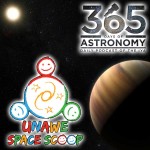Podcaster: Richard Drumm
 Title: Space Scoop: A Whole New World
Title: Space Scoop: A Whole New World
Organization: 365 Days Of Astronomy
Link : astrosphere.org ; http://unawe.org/kids/unawe1501/
Description: Space scoop, news for children.
Bio: Richard Drumm is President of the Charlottesville Astronomical Society and President of 3D – Drumm Digital Design, a video production company with clients such as Kodak, Xerox and GlaxoSmithKline Pharmaceuticals. He was an observer with the UVa Parallax Program at McCormick Observatory in 1981 & 1982. He has found that his greatest passion in life is public outreach astronomy and he pursues it at every opportunity.
Today’s sponsor: This episode of “365 Days of Astronomy” is sponsored by — no one. We still need sponsors for many days in 2015, so please consider sponsoring a day or two. Just click on the “Donate” button on the lower left side of this webpage, or contact us at signup@365daysofastronomy.org.
Transcript:
This is 365 Days of Astronomy. Today we bring you a new episode in our Space Scoop series. This show is produced in collaboration with Universe Awareness, a program that strives to inspire every child with our wonderful cosmos.
Today’s story is…
A Whole New World
Aladdin might have sung about showing Jasmine a ‘whole new world’ in the Disney movie, but the words could really belong to the ESO, the European Southern Observatory. Thanks to one of their telescopes, we’re able to study for the very first time a planet beyond our Solar System using normal starlight reflected off its surface!
Almost 2,000 so-called exoplanets have now been discovered. Astronomers have found almost all of them using clever tricks such as the radial velocity method, where a star is tugged a tiny bit by the gravity of it’s largest orbiting planets.
Also astronomers use gravitational lensing, where a closer star’s gravity bends light from a more distant star that’s right behind it. By studying the bending of the light it’s possible to detect planets orbiting the closer star.
It’s also possible to detect exoplanets when they pass directly in front of their parent star from our point of view and ever-so-slightly dim the light output that we can detect here on Earth.
This is all difficult, exacting work because planets are incredibly dim and far away. They are easily lost in the glare of the dazzlingly bright stars they orbit. Trying to directly photograph a distant planet is like trying to see the light of a moth flying around a searchlight. From hundreds of miles away!
51 Peg b isn’t a very exciting name, but it’s the name of an exciting planet that’s in orbit around the star 51 Pegasi in the constellation Pegasus. The album artwork for today’s episode is an artist’s impression of what this planetary system might look like.
Twenty years ago it became the first exoplanet to be discovered orbiting around a normal main-sequence star like our Sun. Now, it has earned a new record: as the first exoplanet to be directly spectroscopically studied in visible light.
7 astronomers from Portugal’s Universidad do Porto, 1 from France, 5 from Geneva Switzerland and 1 from Chile used the HARPS spectrograph on the 3.6 meter ESO telescope at La Silla Observatory in Chile to make this discovery.
HARPS usually is used to make spectroscopic radial velocity exoplanet discoveries, but in this case it was used to study the spectrum of this planetary system. The team of astronomers is eagerly awaiting the ESPRESSO spectrograph to be completed at the larger VLT telescopes of Paranal Observatory so that they can do more detailed and precise studies of this and other planetary systems.
The ability to collect light from distant worlds is very exciting. It will allow us to work out all sorts of new facts about them. We can now measure their size, their orbital inclination or how edge-on or face-on the orbit is and the planet’s overall reflectivity or albedo. This can be used to infer the composition of the planet’s surface and atmosphere.
For example, we’ve learned that 51 Peg b has a mass about half that of Jupiter, and it is much less dense than Jupiter. So much so that it’s diameter is larger than Jupiter. Which isn’t so surprising, we have the case of Saturn here which is almost as large as Jupiter and has such a low density that it would float on water! 51 Peg b is also very reflective.
It’s orbit is inclined 9° from Earth so it won’t be transiting in front of 51 Peg. It also orbits much closer to its parent star than Jupiter does to our Sun. This makes it a giant, blisteringly hot world, what astronomers call a “Hot Jupiter”. It’s sort of the poster child of Hot Jupiters since it was the first of the many that have been detected. It might not be the sort of place you’d want to visit, but this technique is a step in the right direction for exoplanet hunters.
Hey, Here’s a Cool Fact:
Scientists have calculated that billions of stars in our Galaxy will have between 1 and 3 planets that could have liquid water on the surface – the vital ingredient for life!
Thank you for listening to 365 Days of Astronomy!
End of podcast:
365 Days of Astronomy
=====================
The 365 Days of Astronomy Podcast is produced by NUCLIO. Audio post-production by Richard Drumm. Bandwidth donated by libsyn.com and wizzard media. You may reproduce and distribute this audio for non-commercial purposes. Please consider supporting the podcast with a few dollars (or Euros!). Visit us on the web at 365DaysOfAstronomy.org or email us at info@365DaysOfAstronomy.org. This year we celebrate cosmic light as light is our info messenger in the universe. Join us and share your story to celebrate the International Year of Light. Until tomorrow! Goodbye!

